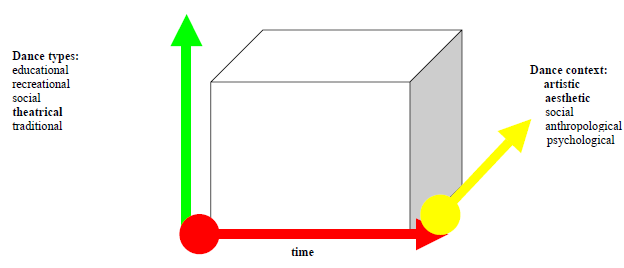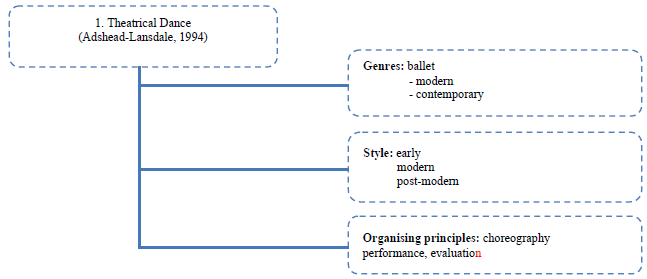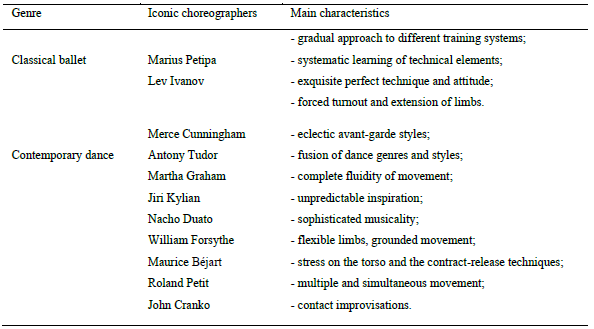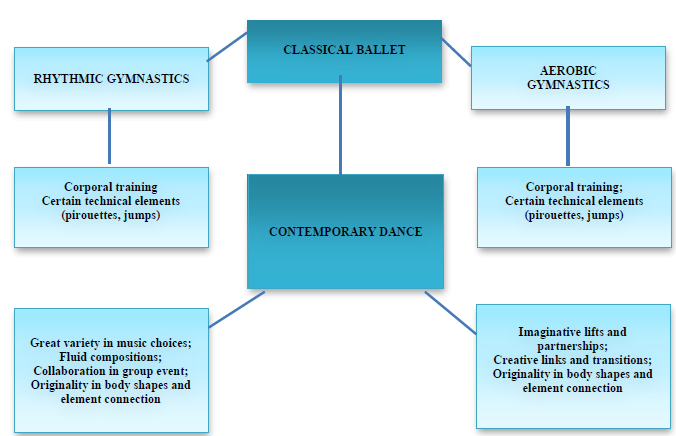Contemporary Trends in Choreography – Potential for Enhancing the Artistic Preparation in Rhythmic and Aerobic Gymnastics
Abstract
This paper intends to bring new insights for optimizing the training process by conceptualizing and building an argument on the need to analyse the significant trends in modern and postmodern dance, in order to pick relevant statements, visions and means to be applied in different gymnic sports preparation types. Coaches and choreographers working in rhythmic or aerobic gymnastics need to have a deeper understanding of dance as a fundamental form of human expression, which, in different formulae, can be transferred into the sport arena. Taking into consideration the current literature, as well as the practical experience of some Romanian experienced coaches, we can assume that ballet is an indispensable form of training for the gymnasts, while modern and postmodern dance is a precious source of inspiration for choreographers, specifically due to the fusing styles, visions, cultures and genres of dances discussed in this paper. The iconic works of choreography defy or utilize gravity, balance energy and power, design perfect lines and volumes integrating the music, all these elements being equally important in artistic sports. Empowering the gymnasts to reach a higher understanding and control of their bodies derived through ballet and dance experiences is a task that coaches should undertake, so that every limb or muscle to be vibrantly present and able to express a wide range of emotions. The paper designs a structured model to explore the contemporary dance, obviously suitable for further developments, so that artistic preparation follows new approaches and emphasizes a new, fresh stylization of movements.
Keywords: Artistic preparation, gymnic sports, choreographic trends
Introduction
This paper intends to bring new insights for optimizing the training process by conceptualizing and
building an argument on the need to analyse the significant trends in modern and postmodern dance, in
order to pick relevant statements, visions and means to be applied in different gymnastic sports
preparation types.
The incredible evolution of artistic sports worldwide has definitely shown a constant struggle for
reinventing concepts and means of artistry, so that this domain can move into this millennium in a
fresh, vigorous and meaningful manner. In this perspective, coaches and choreographers working in
rhythmic or aerobic gymnastics need to have a deeper understanding of dance as a fundamental form of
human expression, which, in different formulae, can be transferred into the sport arena (Dragnea &
Teodorescu, 2002).
Taking into consideration the current literature, as well as the practical experience of some
Romanian skilled coaches, we can assume that ballet is an indispensable form of training for gymnasts,
while modern and postmodern dance is a precious source of inspiration for choreographers, specifically
due to the fusing styles, visions, cultures and genres of dances (Kraus & Chapman, 1981) discussed in
this paper.
As Epuran (2013) or Dragnea and Bota (1999) stress in their studies, exploring the world is
irrevocably connected to physical experience, a subtle interchange being revealed between the body as
a biomechanical system and the whole of perceptions, feelings and thoughts that accompany human
movements, from an educational, artistic or sports-oriented perspective. This kind of interconnectivity
is a basic matrix in artistic gymnastic sports, wherein the process of creating and expressing these
movements is a challenge for both technicians and athletes (Vişan, 2005; Grigore et al., 2001; Urzeală,
2006).
The iconic works of choreography defy or utilize gravity, balance energy and power, design perfect
lines and volumes integrating the music, all these elements being equally important in artistic sports.
Empowering the gymnasts to reach a higher understanding and control of their bodies derived through
ballet and dance experiences is a task that coaches should undertake, so that every limb or muscle to be
vibrantly present and able to express a wide range of emotion (Marshall, 2002).
This paper aims at designing a structured model to explore contemporary dance, obviously suitable
for further developments, so that artistic preparation in gymnastic sports follows new approaches and
emphasizes a new, fresh stylization of movements.
Materials and methods
In the light of those mentioned above, we present in the following the main choreographic trends in
modern and postmodern dance, as revealed in the current literature, so that this legacy can be valued in
artistic sports in a more extensive way.
The working methods employed were the historical overview, as well as the selection and
interpretation of the facts in a significant manner for the artistic sports. Chronological progression is
the main criteria but not the exclusive one, as the authors were either diachronic or synchronic in
selecting particular topics of interest.
Content
The study of dance history and choreographic visions as a body of knowledge emphasizes a
multiplicity of philosophical, sociological or training aspects which recommend this complex activity
as a strong educational environment. The proliferation, development, decline or transformation of
certain choreographic trends over time is an inexhaustible resource for artistic expression, which can be
tailored and adapted to the specificity of rhythmic and aerobic gymnastics.
In an excellent essay about artistic creation, Forsythe (2010) expresses brilliant ideas that are
profoundly inspiring and motivating for all those involved in a choreographic discovery process: the
continuous novelty, the impossibility of giving a standard definition for the term Choreography, the
“detachment of ourselves from positions of certainty”, the endless search for multiple incarnations of
ideas, the elusiveness and mental mobility required or the biomechanical rules governed by exception.
Described as a “channel for the desire to dance”, choreography is often thought to reside in the body,
but in Western cultures, it is also an autonomous expression that may transcend the corporality in any
other space… perceptual, mental or emotional.
Given the complexity of the dance analysis, this study presents a synthetic chronological description
of the main currents and their representatives, and, in the end, an original rationale, a model to inspire
trainers and choreographers to absorb dance elements in the gymnasts’ artistic preparation.
Ballet, modern dance, postmodern (contemporary) dance – an arch over time
The early history of ballet starts with the coming of the Renaissance in Italy and France, being
represented by court dances, and then, the court ballet. In the 18th century, the Action ballet took the
first step, imposing technical virtuosity over grace and professional dancers as well.
The 19th century is the period of the Romantic and Imperial ballet with performances in two acts,
predominance of the female dancer, use of pointes, prevalence of lyric expression over technical skills,
European mythology themes, the birth of Mariinsky Theatre in Saint Petersburg - choreographically
influenced by the French and Italian schools, theatrical sense, mime, stylized folklore integrated into
ballet etc. Through the contribution of Jules Perrot, Charles Didelot, Enrico Cecchetti, the prestigious
Russian ballet gained world eminence through Anna Pavlova, Leonid Massin, Ninette de Valois, Anton
Dolin or Serge Lifar.
In the same time, influential artists came to Russia, like Marius Petipa, considered the best
choreographer in classical ballet, enriching the existing body of knowledge. Among his famous
original works are Don Quixote, La Bayadere and The Sleeping Beauty. He also revived several
ballets, such as The Swan Lake, Giselle, Le Corsaire, La Sylphide and Coppelia, being renowned for
his detailed research on each production he staged, including dictating the kind of music he wanted -
the tempo, beat, dynamics or style, even if the composer was Tchaikovsky himself.
The reason for the extraordinary early development of the Imperial ballet lies in the ability to learn,
copy, borrow and adapt the influences, and then “mould them into the eclectic art of the Russian
ballet”, bearing the stamp of the national genius (Dance Encyclopaedia, 1949: 411).
The 20th century includes a myriad of styles and schools, a tremendous proliferation of young
choreographers belonging to Modern and Contemporary Ballet. This period up to present is
characterized by a mix of classical legacy and contemporary visions promoted by famous ballet
companies. The main representatives who have made a huge step in innovating the artistic content are
Serge Diaghilev, Michel Fokine, Maria Rambert, George Balanchine, John Cranko, Maurice Béjart,
Keneth Mac Millan, Jirí Kylián, William Forsythe, Mats Ek, Nacho Duato, Jean Christophe Maillot,
Sylvie Guillem, Russell Maliphant.
Dance historians assert thatencompasses the period from the beginning of the 20th
century up to the 1950s. Its birthplaces were Europe (especially Germany) and the United States. It
emerged from time evolution itself, music trends and related social facts which occurred in Western
culture, bringing new insights and unique interpretations of the world and the inner self (McDonaugh,
1970: 53; Ginot & Michel, 2002).
Modern dance is defined and seen by many experts as a manner to manifest against formalism and
conventional choreographies.
Renowned creators have left a significant mark on the modern dance concept, as follows (the reader
being aware that the authors did not intend an extensive approach in the matter):
Francois Delsarte - “feelings and their intensity are the cause of movement and its quality”; the
source of inspiration lies inside the human; creation of the concept of gesture expressiveness; the upper
body (trunk, face, arms) is the main vehicle for transmitting feelings; new code of gestures (Kraus &
Chapman, 1981).
Emile Jacques Dalcroze - relationship between movement and rhythm; creator of a new approach to
movement, called Eurhythmics; asserts the importance of breathing and relaxation for a proper body
movement.
Rudolf Laban - creator of the conceptual basis of modern dance; inventor of Labanotation; human
movement expresses the social state of being; dance can adjust society in a positive way.
Mary Wigman - founder of German expressionism; radical opponent to classical dance; the dancer’s
soul is captivated by invisible forces which create dance.
Doris Humprey - “movement is situated on a tended arc between two deaths”; introduction of the
biomechanical principle of fall and recovery; focus on group compositions, which can achieve the
perfect harmony of an orchestra; reveals the autonomy of dance towards music; creator of a teaching
method emphasizing the difference between instruction and education through dance (Kraus &
Chapman, 1981; Cohen, 1995).
Martha Graham - the most famous figure in American modern dance, she reveals the “centre” of
the body and the movement of the pelvis; focus on alternating contraction and release; importance
given to a pioneer spirit, mystical spirituality, framed in an original choreographic vocabulary; certain
sequential techniques and rules for the engagement of the body up to reaching its maximum energetic
potential; new movements coming from inside her inner, but adding spasm and resistance to them, by
inventing many beautiful falls and recoveries from the ground, creating a whole range of balancing on
bent knee techniques, inventing turns with a changing axis; a varied range of musical themes -
orchestral music but also dance just to the spoken word, many of the musical works, composed for
Graham’s dances, being acknowledged as contemporary compositions of great value; the use, for the
first time, of Afro-American and Asian dancers in her dance assembly, in opposition to other earlier
assemblies, which had already established impassable barriers with regard to this aspect.
Alvin Ailey - the top representative of black modern dance; his masterpiece entitled “Revelations”
(1960) is considered a milestone in this area, gathering aesthetic choices like lyric spirit, ethnic music,
Graham technique, revolutionary atmosphere; multiethnic artistic possibilities.
Pina Bausch - one of the greatest personalities of the 20th century; her theatrical dance represented a
form of revolt against classical ballet which, according to her opinion, was stuck in provinciality and
obedience; rejection of the harmonious and aesthetic dance and focus on the expressionism of the
movement; a particular way of creating emotions - “Improvisation and the memory of [the dancer’s]
own experiences... Bausch asked questions about parents, childhood, certain feelings, likes/dislikes list,
aspirations. The answers developed gestures, sentences, dialogues or little scenes”; total freedom to
choose any expressive mode is the key-element, whether it is verbal or physical, this freedom giving
the dancer the feeling of security in searching his/her deepest feelings (Bremser & Sanders, 1999).
Ballet history and modern dance history are regarded by specialists (Ginot & Michel, 2002) as a
background for the development of contemporary dance.
encompasses the period between the 1950s up to present, being characterized
by an ease of movement due to the natural lines, fluidity and energy of the body. Specialists mark its
great versatility and the limitless possibility to create new styles of action, to use any music in order to
push the limits of the experienced dancers in expressing their innermost feelings.
As this form of art continues to increase every day, the following remarks provide a selection of the
most important figures and trends that are a constant source of inspiration for movement creators,
including sport specialists.
Merce Cunningham - a great disciple of Martha Graham, a creator of new artistic postulates, an
“innovator in all possible perspectives: compositional, technical-interpretative, musical and
philosophical”; the abstract, expressive movement exists beyond intention, without the need to tell a
story; deconstruction of rules in terms of symmetry, space concepts, hierarchies; mastery of rhythm and
movement by inner perception; unpredictable way of changing rhythm and direction; dancers must be
seen, not analysed (Kraus & Chapman, 1981).
William Forsythe - a continuator of Balanchine’s work, because of “his way of working with
classical ballet from a contemporary aesthetic perspective. It is said that he places classical ballet
richness and possibilities in a 21st century dynamics” (McDonaugh, 1970: 53).
Maurice Béjart - one of the most influential artists, with flamboyant theatricality and innovative
reframing of classical music and dance sources in an unexpected and controversial fashion.
Jiri Kylian - an emblematic choreographer, incorporating elements of modern dance into the ballet
vocabulary; worked on limitations and capabilities of space and body parts, contrasts, and humoristic
sequences; influenced by surrealism and minimalism; mix of classical lines and percussive movements
which make the whole piece unpredictable.
Nacho Duato - one of the “heavyweights” of contemporary dance; dynamic, expressive, fluid and
fast movements positioned in the halfway between classical and abstract; the label of his works is the
exceptional musicality; music is translated into shapes, lines, images, even smell (when creating Jardi
Tancat, he even suggested his dancers to smell orange blossom while listening to music); use of head
and arms in an endless articulated way, “without falling into gestural movement”; great use of partnering, with highly-flawless complex sequences of “pas de trois”, as a main choreographic
formulae.
Gigi Căciuleanu - a famous contemporary Romanian choreographer for whom the dance is an art
which essentializes the life itself. To conceive a choreography is “to merge geometry and grammar,
architecture and music, sculpture and game strategy…”. For him, “the dance is the art of sculpturing
the time with a body in motion…” (Căciuleanu, 2008). Although his theatrical, dynamic style is a
trademark, his compositions reveal the fact that simplicity conveys maximum complexity in terms of
ideas, states, feelings or concepts.
3.1. A structured model to use dance in rhythmic and aerobic gymnastics
In Figures 1 and 2, we present schematically the three-dimension model which could be used for
enriching the training process and also the choreographic vision in artistic sports.


By combining these types, genres and styles of dance, the specialists working in sports area could
improve, innovate or refresh the body of knowledge, the strategic vision and the means of expression,
which might not only impose their athletes in the world top, but also develop rhythmic and aerobic
gymnastics to further horizons, crossing boundaries in their pursue towards memorable creations
(Table 1 and Fig. 3).


Conclusions
1. Classical dance and contemporary dance are of equal interest for the technicians in gymnastic
sports, although sometimes insufficiently capitalized in a consistent manner. No gymnast could reach a
high technical development without the ballet training, just like no sports choreographer could have
access to creative and experimental strategies without a deep knowledge of what the world of dance
means (Adshead-Lansdale & Layson, 1994).
2. Iconic contemporary choreographers - William Forsythe, Maurice Béjart, Jiri Kylian, Nacho
Duato, are most likely to inspire technicians in creating innovative technical alternatives for the
routines, in both rhythmic and aerobic gymnastics.
3. Such dance choreographers require the dancers to adopt sophisticated creative strategies that
differ between dance projects, just like gymnasts would have to reinvent themselves according to the
events or the apparatus with which they are working.
4. The performance of a gymnast encapsulates a perfect body, physical and technical virtuosity,
exquisite motor control, high sensitivity in transmitting a poignant message to the judges and public, all
these embodied in many different ways, depending on the training methodology, the traditional school
he/she belongs to and definitely the general vision of his/her trainer or choreographer. So, if we were to
give an answer to the question “From where does an expressive movement emerge?” (Roche, 2015),
we might assume that it comes from a deep understanding of sports science principles, but also from
absorbing the amazing dance heritage, as a multidimensional cultural experience.
References
Adshead-Lansdale, J., & Layson, J. (1994). Dance History. A Methodology for Study. London: Routledge. Bremser, M., & Sanders, L. (2011). Fifty Contemporary Choreographers. London: Routledge.
Căciuleanu, G. (2008). Vânt, volume, vectori. București: Curtea Veche.
Cohen, S. J. (1995). Doris Humphrey - An Artist First. Pennington, NJ: Princeton Book Company. Dance Encyclopaedia. (1949). Nicolas Legat. New York: Barnes & Co.
Dragnea, A., & Bota, A. (1999). Teoria activităților motrice. București: Editura Didactică și Pedagogică. Dragnea, A., & Teodorescu, S. (2002). Teoria sportului.București: FEST.
Epuran, M. (2013). Motricitate și psihism în activitățile corporale (Vol. 2). București: FEST.
Forsythe, W. (2010). Improvisation Technologies: A Tool for the Analytical Dance Eye. [Multimedia CD].
Retrieved from http://www.amazon.com/William-Forsythe-Improvisation-Technologies-Analytical/dp/3775721843 Ginot, I., & Michel, M. (2002), La danse au XXe siècle. Paris: Larousse.
Grigore, V., Macovei, S., Manos, M., Popescu, G., & Vişan, A. (2001). Pregătirea artistică în gimnastica de performanţă. Bucureşti: ANEFS.
Kraus, R., & Chapman, S. (1981). History of the Dance in Art and Education. New Jersey: Prentice Hall. Marshall, L. (2002). The Body Speaks. New York: Palgrave Macmillan.
McDonaugh, D. (1970). The Rise and Fall and Rise of Modern Dance. New York: Mentor.
Roche, J. (2015). Multiplicity, Embodiment and the Contemporary Dancer. New York: Palgrave Macmillan. Urzeală, C. (2006). Activități motrice de expresie corporală. București: Cartea Universitară.
Vişan, A. (2005). Dansul pentru educaţia corporală. București: Cartea Universitară.
Copyright information

This work is licensed under a Creative Commons Attribution-NonCommercial-NoDerivatives 4.0 International License.
About this article
Publication Date
10 June 2016
Article Doi
eBook ISBN
978-1-80296-010-5
Publisher
Future Academy
Volume
11
Print ISBN (optional)
-
Edition Number
1st Edition
Pages
1-509
Subjects
Sports, sport science, physical education
Cite this article as:
Bota, A., & Lautaru, C. (2016). Contemporary Trends in Choreography – Potential for Enhancing the Artistic Preparation in Rhythmic and Aerobic Gymnastics. In V. Grigore, M. Stanescu, & M. Paunescu (Eds.), Physical Education, Sport and Kinetotherapy - ICPESK 2015, vol 11. European Proceedings of Social and Behavioural Sciences (pp. 22-29). Future Academy. https://doi.org/10.15405/epsbs.2016.06.4

